
If you’re new to crochet, you may not realize that there are many different sizes of crochet hooks. How do you know which one to use for your project? Hook size is one of the most important things to learn when you’re a crochet beginner, along with choosing the right yarn for your crochet projects, and mastering basic crochet stitches. Understanding crochet hook size can affect many aspects of your crochet projects, so make sure you are familiar with how to choose the right one.
Don’t worry, we’ll walk you through everything you need to know about crochet hook size here! First let’s learn about crochet hook size basics and how to convert from US sizes to metric units, including a handy crochet hook size conversion chart. Next, we’ll talk about the most common hook sizes and which hooks beginners should start with.
Later we’ll talk about how to determine if your hook size is right for you and how to measure your stitches via a crochet swatch and gauge square. Finally, we’ll go over how to make sure you’ll always have the right crochet hook for your pattern.
Did you know: Crochet hooks are also sometimes called crochet needles. The term can be used interchangeably!
Size Basics
The size of a crochet hook corresponds to specific weights of yarn, and crochet patterns usually list a suggested hook size to help you make the pattern as close to the original design as possible. Yarn labels also list a hook size or range of sizes that are recommended to work with that particular yarn.
One thing to be aware of is that crochet hook sizes are not completely standardized. Because crochet has evolved as a folk art over time, and across continents, hook sizes have evolved separately as well. Crochet hooks can be measured in either letters (US) or metric units (UK). Most yarn labels will use one or both types of crochet hook measurements, but there are times when you have to convert the size yourself to make sure you are using the recommended hook size.
Here’s a helpful Crochet Hook Conversion Chart for US and UK crochet hook measurements.

Common Hook Sizes
Crochet hooks come in a wide range of sizes, but you will find yourself reaching for some hook sizes more often than others. For standard crochet hooks, the smaller the hook size, the smaller the letter (US terms), or the smaller the mm size, the smaller the hook (UK/metric terms). What are the most commonly used crochet hook sizes?
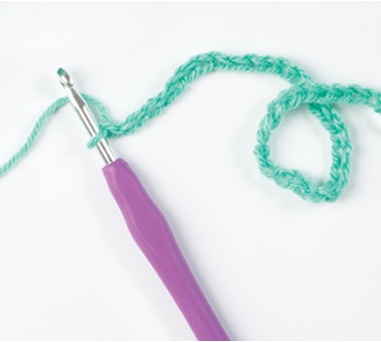
Worsted Weight Yarn Hook
H-8 (US) or 5mm (UK) Metric Size
When you first start to crochet, you will probably be using worsted weight yarn. An H-8 5mm crochet hook is the most common size recommended for use with worsted weight yarn.
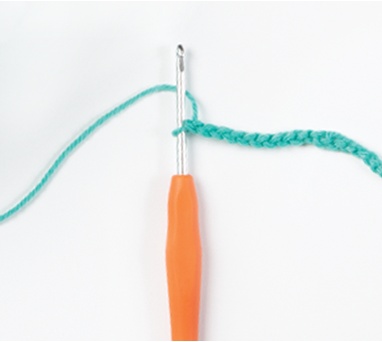
Fingering Weight Yarn Hook
D-3 (US) or 3.25mm (UK) Metric Size
Fingering weight yarn is smaller than worsted weight yarn, so once you get comfortable with your crochet skills, you might want to try this yarn. Try a D-3 3.25mm crochet hook for fingering weight yarn.
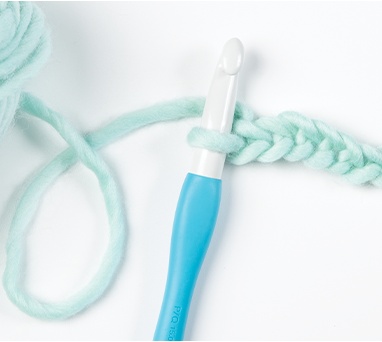
Jumbo Yarn Hook
S-35 (US) or 19mm (UK) Metric Size
If you want to crochet jumbo yarn or roving yarn, strips of fabric, rope, or other very large yarn, you will use a jumbo hook like an S-35 19mm hook. This giant hook is less common because of its large size, but comes in handy if you want to crochet a very bulky project. Of course, there is a range of other sizes of bulky crochet hooks to use as well (that aren’t quite as large!).
Is There a Crochet Hook Size A?
If you read over the Crochet Hook Size Conversion Chart, you’ll notice that crochet hook size A does not exist. The US crochet hook sizes start at the letter B-1 (which is 2.25 mm) and go up from there. However, you can find crochet hooks that measure 2mm, which would suggest that they could be considered a US size A. Technically, however, there is no crochet hook size A according to the crochet hook standards set by the Craft Yarn Council.
What Crochet Hook Sizes Should a Beginner Buy?
To get started as a beginner crocheter, you’ll want a few crochet hooks to choose from. Beginner hook sets can range from sizes E-J (US); 3.5mm - 7mm (UK). We like the WeCrochet Bright Hook Set because it is inexpensive and includes 9 hooks starting at size 2mm ranging up to J-10 6mm.
How Are Tunisian Hooks Sized?
Tunisian crochet hooks are measured the same way as standard crochet hooks and adhere to the same size measurements as listed in the chart above. The difference for Tunisian hooks is simply that they have a cord connecting to their end to allow you to carry stitches on the cord. Learn more about Tunisian crochet in our tutorial: All About Tunisian Crochet.
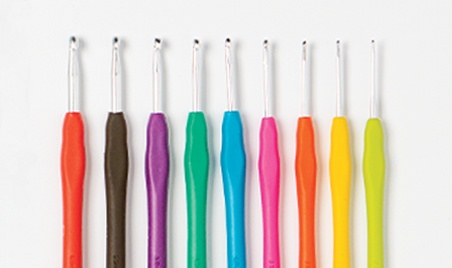
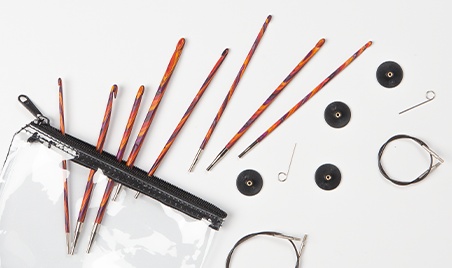
What If My Crochet Hook Size Is Not Labeled?
Sometimes crochet hooks are not labeled with a size, which can be frustrating. This is common with older crochet hooks (such as the ones you might have inherited from your grandparent!). It’s a good thing hook sizing is now standardized, and we can figure out the size of any crochet hook!
You can easily measure the hook size with a knitting needle and crochet hook gauge tool. These little tools have holes in them that are drilled to specific millimeter measurements. Just insert your hook into the hole until you find the one that fits, and then you’ll know exactly what size you’re working with. These tools also work to measure your knitting needle size, which is handy if you enjoy doing both crafts.
Crochet Thread Hook Sizes
Steel crochet hooks are the smallest hooks and are not represented on the standard size Crochet Hook Size Conversion chart. These hooks are used for fine thread crocheting such as crochet lace or doilies and usually used with crochet thread like Curio #10. They also differ from standard crochet hooks because they are made of a stronger metal (steel) to keep the tiny hooks from bending while you work. Beware! Steel hooks generally have very sharp ends. In fact, many steel crochet hooks come with a metal cover to protect the end of the hook (and your project bag!).
If you are using crochet thread and steel crochet hooks, they are measured a different way because of their tiny size. For the UK/Metric system, crochet hooks are still measured in millimeters, but US thread hooks are measured in a number system that gets higher as the hook gets smaller.
Crochet Gauge Square
When you look at a yarn label or crochet pattern, they list a suggested crochet gauge. What’s crochet gauge? It’s an estimated number of crochet stitches per inch or 4 inch square. To determine your own gauge, you’ll measure the stitches across a 4 inch section of your crochet. Read on for instructions on exactly how to do it.
For best results when making a pattern, make a crochet gauge swatch that uses the stitch pattern that you’ll be working for that project. Although a pattern’s suggested gauge often measures a 4 inch square, you should make a swatch that is about 6 inches square, to allow you to measure the middle of the swatch, because measuring the foundation row or sides can affect the accuracy of your gauge measurement.
Once you complete your crochet swatch, wash and block it to the pattern or yarn instructions to get the most accurate crochet gauge. Allow the blocked swatch to dry before measuring for gauge. For more information on blocking, read our tutorial: How to Block Crochet.
You can use a ruler to measure your crochet gauge, but a crochet gauge square is our favorite tool for measuring gauge. A crochet gauge square is a small square used to determine stitch lengths and gauge how tight or loose stitches are based on yarn weight and hook size.
If you like DIY projects, you can make your own crochet gauge square by cutting a 4 inch square hole in a piece of cardstock, or you can buy a gauge swatch ruler that is designed to help you determine your gauge.
To use a crochet gauge square, lay the square over your blocked crochet swatch, in the middle of the swatch. Then count the number of stitches across the 4” as well as the number of rows from top to bottom. Divide by 4 to figure out how many stitches or rows you are making per inch. You want this number to match the gauge in the pattern or on the yarn label.
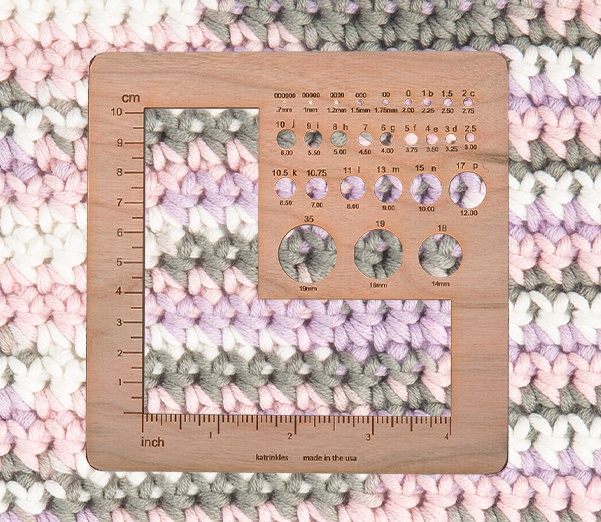
What If My Crochet Gauge Doesn’t Match?
Getting the correct crochet gauge is most important for projects that need to be a specific size, like garments, accessories, or some toys. It’s also important to get the correct gauge if your project uses an intricate stitch pattern or cables. For other crochet projects, like afghans and blankets, gauge isn’t always as important, so it’s okay if your crochet gauge measurements are close but not exact.
Don’t panic if your crochet gauge doesn’t match! Most crocheters don’t get an exact match on their first swatch. It’s fairly simple to correct your crochet gauge. If you have too many stitches per inch, try switching to a larger hook. If you have too few stitches per inch, try a smaller hook size.
Sometimes you have to crochet two or more gauge swatches to get the correct gauge, so don’t be discouraged. This is just part of the crochet process. It’s better to spend an hour on a swatch or two, than to put weeks of crocheting into a project just to discover it’s much too large or far too small!
Crochet Gauge Tip:
Once you’ve determined your crochet gauge and started your project, check your work with the gauge square every few inches of your project to make sure you are maintaining the desired gauge throughout.
Hook Size Recommendation for Beginners
Now that you know all about hook size, it’s time to make sure you have the hooks you need. We recommend that beginners buy a set of hooks that include a H-8 5mm hook.
It’s also worth noting that different types of crochet hooks have different head styles (either tapered or inline), and can be made of many materials (like metal, wood, or acrylic). Each hook material has its own qualities that affect your crocheting experience and interacts differently with the yarn you choose. You can learn all about crochet hook materials and shapes in our Guide to Crochet Hooks.
Great Hook Sets for Beginners:
Although many people use and love straight aluminum hooks, we highly recommend using ergonomic crochet hooks that have some kind of rubber handle or other ergonomic features. Because of the repetitive motion of crochet, having that extra cushion can make your hours of crochet time cozy and comfortable and help avoid stress and strain to your hands and arms.






